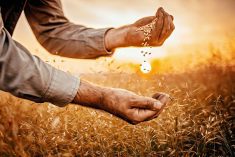NAIROBI, Kenya – Mary Mutola Kotta moved from the countryside to this sprawling city more than 20 years ago, hoping to find better work than was available in her low-income agricultural background.
She ended up back on the farm, in this case a 20-acre farm that has been built on government-owned land within Nairobi’s city limits.
“We came to look for jobs,” said the 49-year-old.
“This was the only job we found.”
It is a job that supports 27 large families and that sells through 180 purchasers into city markets.
Read Also

Taking a look inside Canada’s seed regulatory overhaul
ive years, eight task teams, 130 volunteers and 135 recommendations later, Canada’s seed industry is still waiting for meaningful regulatory change.
The clientele for the farm’s vegetable production comes largely from the city slums among the majority of Nairobi residents who earn less than $2 per day and cannot afford the more expensive processed fare in the supermarkets.
That means the farm has not been able to cash in on the higher prices rocking food markets around the world but particularly in developing countries where the diet is more likely to be raw commodities than processed food in which staples represent a small portion of the final product.
“The people who are buying from us are poor so we really can’t charge more,” said Kotta’s partner in the farm business, Michael Kamau, who started the operation in 1970 after he too failed to find work in the city.
The farm is part of a large and growing phenomenon in developing world countries – urban agriculture.
It usually operates in a grey area, not approved by government but tolerated, largely unregulated and subject to eviction whenever the landowners decide to move the farmers. Environmental practices, noise and smells often raise the ire of neighbours.
And yet urban farms are a huge factor in feeding sprawling developing country cities.
Francois Gasengayier, a senior program officer at the International Development Research Centre (IDRC) in Nairobi, said farms within the city provide 40 percent of the food consumed in Nairobi. At the United Nations Food and Agriculture Organization in Rome, horticultural crop group consultant Wilfried Baudoin estimates that up to 80 percent of vegetables consumed by Nairobi’s majority poor population come from urban agriculture.
And it is not just vegetables. Many residents keep livestock in the city: in their backyards and on vacant land that they have sometimes occupied for decades.
In 2007, FAO estimated 45,000 goats and sheep, 240,000 chickens and 24,000 dairy cattle were kept within Nairobi city limits.
It is estimated that inner-city fish farming in Bangkok, Thailand, generates $75 million US a year.
And in the western Kenyan centre of Nakuru, it is estimated that 35,000 families work in urban agriculture, at least 8,500 of them full time.
It is a mainstay of the developing world food supply and a far cry from the balcony or backyard gardens that pass as urban agriculture in Canada.
But it also is a tenuous life because most farmers do not own their land or have security of tenure.
“Anytime they want, they can come and take the land,” Kamau said. “But if they do that, it will displace a lot of people.”
More than 50 people belong to Kotta and Kamau’s extended families.
No houses were in the area when Kamau first started growing food on the site in 1970. Now it is valuable land owned by the state National Social Security administration, and houses are being built on the edge of his fields.
“I don’t know how long they will let us stay here.”
FAO, working with the Canadian crown corporation IDRC and others, is trying to convince governments to recognize the importance of urban agriculture, create rules and standards that offer security and allow investment and improvement.
It also sponsors training for urban farmers to ensure they understand and practise good and responsible animal husbandry, chemical use and waste disposal practices.
Many urban farms also depend on untreated urban waste water, including sewage, with the health risks and contamination that brings.
On Kamau’s operation, by the time the sewage water gets to the farm it has been filtered through crops and land to be relatively clean although Kotta complains purified water without the sewage nutrients is not as good for the crops.
IDRC also sponsors a project to give Kotta and Kamau’s farm another commercial option. Workers are preparing fields where certified seed will be grown to sell to other farmers.
“It will be another crop,” Kamau said.
“It will be a high value crop,” added Kuria Gathuru of Kenya Greentowns Association, a group that works on waste water recycling projects.
“They will be moving a step up in the value chain.”














